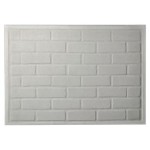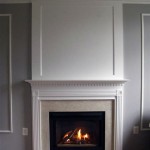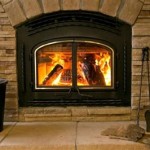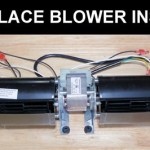Gas Vented Fireplace Inserts: Enhancing Efficiency and Ambiance
Gas vented fireplace inserts represent a sophisticated and efficient method for upgrading existing masonry or prefabricated fireplaces. These inserts offer a balance of aesthetics, convenience, and heating performance, making them a popular choice for homeowners seeking to improve their fireplace functionality and reduce energy costs. This article will explore the features, benefits, and considerations associated with gas vented fireplace inserts, providing a comprehensive overview of this heating solution.
A gas vented fireplace insert is a self-contained unit designed to fit within the existing firebox of a traditional fireplace. It operates on natural gas or propane and utilizes a venting system to exhaust combustion byproducts safely outside the home. Unlike traditional open-hearth fireplaces, which are notoriously inefficient, gas vented inserts are designed to maximize heat output and minimize heat loss up the chimney. They achieve this through features such as sealed combustion chambers, heat exchangers, and variable-speed blowers.
Key Point 1: Understanding the Components and Functionality
The core components of a gas vented fireplace insert include the firebox, burner system, venting system, and control system. The firebox is the enclosure containing the gas burner and designed to withstand high temperatures. Burner systems commonly employ ceramic logs, glass beads, or other decorative media to simulate the appearance of a wood-burning fire. The venting system is crucial for safely expelling exhaust gases, and the control system regulates gas flow, flame height, and blower operation.
The functionality of a gas vented insert centers on efficient combustion and heat transfer. Natural gas or propane is supplied to the burner system, where it is ignited to produce a controlled flame. The design of the burner and firebox promotes complete combustion, minimizing the production of harmful emissions such as carbon monoxide. Heat generated by the flame is then transferred to the air through a heat exchanger, a component consisting of metal fins or coils that maximize surface area for heat transfer. A variable-speed blower circulates the heated air into the room, distributing warmth evenly and efficiently.
Venting systems for gas fireplace inserts are categorized as either direct-vent or B-vent. Direct-vent systems draw combustion air from outside the home and exhaust combustion byproducts directly outside through a coaxial or concentric vent. This sealed system prevents the introduction of indoor air into the combustion process, improving efficiency and safety. B-vent systems, on the other hand, utilize existing chimneys for venting, drawing combustion air from within the home and exhausting gases through the chimney. B-vent systems require careful inspection of the existing chimney to ensure proper draft and safety.
Control systems for gas vented fireplace inserts range from simple on/off switches to sophisticated programmable thermostats and remote controls. Thermostatic controls allow the user to set a desired room temperature, and the insert will automatically adjust its heat output to maintain that temperature. Remote controls provide added convenience, allowing the user to adjust the flame height, fan speed, and temperature from a distance. Some models offer smart home integration, enabling control through mobile apps and voice commands.
Key Point 2: Advantages of Gas Vented Fireplace Inserts
Gas vented fireplace inserts offer numerous advantages over traditional open-hearth fireplaces and other heating alternatives. One of the most significant benefits is improved energy efficiency. Open-hearth fireplaces can lose a substantial amount of heat up the chimney, often resulting in a net heat loss for the home. Gas vented inserts, with their sealed combustion chambers and heat exchangers, significantly reduce heat loss and can achieve efficiencies of 70% or higher. This leads to lower energy bills and a more comfortable living environment.
Convenience is another key advantage of gas vented fireplace inserts. Unlike wood-burning fireplaces, gas inserts require no wood storage, chopping, or handling. Lighting a gas fireplace is as simple as flipping a switch or pressing a button. Furthermore, gas inserts produce minimal ash and require less frequent cleaning compared to wood-burning fireplaces. This translates to less maintenance and more time to enjoy the warmth and ambiance of the fire.
Safety is a paramount concern when operating any type of heating appliance. Gas vented fireplace inserts are designed with multiple safety features to protect homeowners. These features include flame sensors that automatically shut off the gas supply if the flame is extinguished, oxygen depletion sensors that monitor oxygen levels in the room, and sealed combustion chambers that prevent the escape of harmful gases. Direct-vent systems further enhance safety by drawing combustion air from outside the home and expelling exhaust gases directly outside, minimizing the risk of carbon monoxide poisoning.
Aesthetically, gas vented fireplace inserts offer a wide range of design options to complement any décor. They are available in various sizes, styles, and finishes, including traditional, contemporary, and transitional designs. Log sets can be crafted from realistic-looking ceramic logs, and decorative glass beads or stones can be used to create a more modern aesthetic. The flame height and intensity can be adjusted to create the desired ambiance, and some models offer accent lighting to further enhance the visual appeal.
Reduced emissions are an added benefit of gas vented fireplace inserts. Natural gas and propane are cleaner-burning fuels than wood, producing significantly less particulate matter and other pollutants. This makes gas inserts a more environmentally friendly heating option, particularly in areas with air quality concerns. The EPA has certified many gas fireplace inserts as meeting stringent emission standards, further validating their clean-burning performance.
Key Point 3: Considerations for Installation and Maintenance
Proper installation is crucial for the safe and efficient operation of a gas vented fireplace insert. It is highly recommended to hire a qualified and certified installer to ensure that the insert is installed according to manufacturer specifications and local codes. The installer will assess the existing fireplace and chimney, determine the appropriate size and type of insert, and connect the gas line and venting system.
Before installing a gas vented fireplace insert, it is essential to inspect the existing chimney for any signs of damage or deterioration. Cracks, leaks, or obstructions in the chimney can compromise the venting system and pose a safety hazard. If the chimney is deemed unsuitable for use with a gas insert, it may need to be repaired or relined. Relining involves installing a new flue liner inside the existing chimney to create a sealed and airtight venting pathway. A professional chimney sweep can perform a thorough inspection and recommend any necessary repairs or relining.
Gas line connections must be performed by a qualified gas fitter to ensure that the gas supply is properly connected and that there are no leaks. The gas line should be sized appropriately to provide sufficient gas flow to the insert, and a shut-off valve should be installed for safety. It is also important to ensure that the gas pressure is within the manufacturer's recommended range. Improper gas line connections can lead to gas leaks, which are a serious safety hazard.
Regular maintenance is essential for maintaining the performance and longevity of a gas vented fireplace insert. The burner system should be inspected and cleaned annually to remove any debris or soot that may accumulate. The venting system should also be inspected regularly for any obstructions or leaks. The blower motor should be lubricated as needed to ensure smooth operation. A professional inspection and cleaning by a qualified technician is recommended at least every other year.
Homeowners should be familiar with the safety features of their gas vented fireplace insert and know how to operate them properly. This includes understanding the location of the gas shut-off valve, the operation of the flame sensor and oxygen depletion sensor, and the proper procedures for lighting and extinguishing the fire. It is also important to have a working carbon monoxide detector installed in the home and to test it regularly. Carbon monoxide is a colorless and odorless gas that can be produced by incomplete combustion, and it can be deadly if inhaled.
The cost of a gas vented fireplace insert can vary depending on the size, style, features, and brand. Installation costs can also vary depending on the complexity of the job and the need for any chimney repairs or relining. Homeowners should obtain multiple quotes from different installers and compare their prices and services before making a decision. While the initial investment may be significant, the long-term benefits of improved energy efficiency, convenience, and safety can outweigh the costs.
Ultimately, gas vented fireplace inserts offer a compelling solution for homeowners seeking to enhance the functionality and aesthetics of their fireplaces. By understanding the components, benefits, and considerations associated with these inserts, homeowners can make informed decisions about whether a gas vented fireplace insert is the right choice for their needs and circumstances. Careful planning, professional installation, and regular maintenance are essential for ensuring the safe and efficient operation of these appliances.

Empire Direct Vent Gas Fireplace Insert Loft

Oakville Gdix4 Direct Vent Gas Fireplace Inset By Napoleon

Majestic Ruby 25 Direct Vent Gas Insert Ruby25 North Country Fire

Top Direct Vent Gas Inserts In D C

Buy Gas Insert 1 Victory Direct Vent San Francisco Bay Area Ca The Fireplace Element

Freestanding High Efficiency Direct Vent Gas Fireplaces Inserts Stoves Godby Hearth And Home

Superior Gas Fireplace Insert Dri3030c Contemporary

35 Ruby Contemporary Intellifire Touch Direct Vent Fireplace Insert Blower And Remote Electronic Ignition Majestic

White Mountain Hearth Rushmore Direct Vent Insert With Truflame Tech Fireplaces Usa

Majestic Jasper Gas Direct Vent Fireplace Insert Jasper30 Hvacdirect Com








